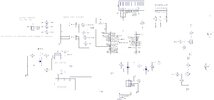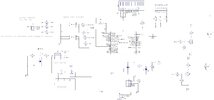Your choice of an 18F2221 micro is odd, and it's lacking a feature you may want: a FVR (Fixed Voltage Reference). This gives you an accurate voltage reference to determine ADC voltage. Without an internal or external voltage reference, your ADC measurements use the PIC's 5 volt supply as the reference. Fortunately, the SRH05S05 DC-DC converter has a tight 1% tolerance on output voltage, so even if you do use +5v as the reference, you should get good results.
Looking at the availability of 18F micros, I'm pretty shocked at all the zero quantity availables I see in Octopart. I'd suggest using an 18F43k22 or 18F44k22 in a pdip package. More micro than you need, but there's availability (for now) at US suppliers. These micros feature a FVR.
Here's a suggestion before everybody who is trying to help puts you on ignore. Instead of putting out an endless stream of sketches where you change one thing and ignore everything else up to this point, how about making a clean schematic with ALL of the changes? That means ALL CONNECTIONS shown, with proper symbols and all lines drawn, and no assumptions about what people will understand that you meant?



